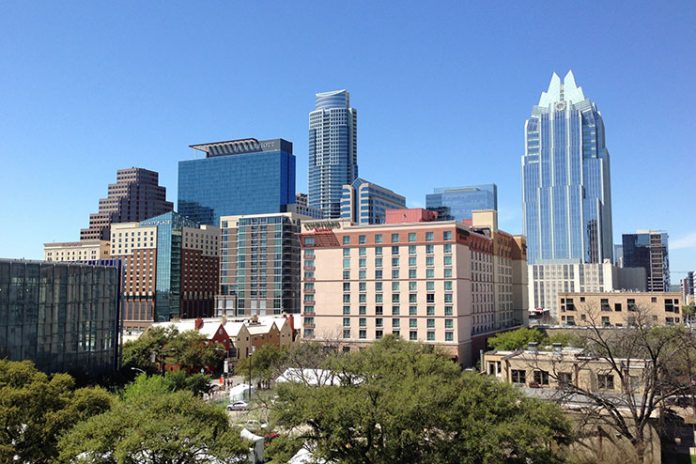
AUSTIN—New hotel rooms coming onto the U.S. market shouldn’t be a concern for established hotel operators because demand will continue to exceed moderating new-supply levels through 2019, according to CBRE Hotels’ Americas Research’s recently released September 2018 Hotel Horizons forecast report.
In Austin, hotels are forecast to see a RevPAR increase of 0.9 percent by year-end 2018 as a result of an estimated decline in occupancy of 0.6 percent and a 1.6 percent gain in average daily room rates (ADR). The 0.9 percent advance in Austin RevPAR is lower than the national projection of a 3.1 percent increase.
Looking towards 2019, Austin RevPAR is expected to grow 1.2 percent—better than the rate of growth in 2018. Austin market occupancy levels are expected to range around 71 percent through 2020.
“Although Austin’s overall RevPAR advance is lower than the national projection, Austin has proven time and again that it is a city which can support significant increases in new hotel supply,” says Jeff Binford, director of CBRE Hotels.
Supply growth in Austin is projected to be 6.1 percent in 2018 and another 5.3 percent in 2019. While this rate of increase is consistent with Austin’s supply increases since 2015—ranging from 5.9 percent to 6.4 percent—it remains much greater than the long-run average of 3.6 percent. Demand for those hotel rooms has closely followed the increases in new rooms. Since 2015, increased room night demand has ranged between 4.2 percent and 7.8 percent.
“Austin still has many new hotels in the pipeline, but we expect the rate of increases will soften in the next couple years,” Binford continues. “While some show concern with a perceived oversaturation of hotel rooms, the growth of Austin’s economy and the continued shift of large companies to this market make hotels an increasingly necessary resource.”
The Economy
“The correlation between the health of the economy and the performance of the lodging industry has long been established. In fact, it is the positive outlook for the nation’s economy in 2019 that explains our baseline forecast for continued growth in U.S. lodging demand,” says R. Mark Woodworth, senior managing director of CBRE Hotels’ Americas Research. “However, like any forecast, there is the potential for actual outcomes to vary from projections. Accordingly, we provide our clients with multiple lodging forecasts based on five different economic forecast scenarios.”
The Austin economy has remained strong with very low unemployment rates. Central Texas has also seen increased manufacturing output and a rise in loan demand and retail spending, indicating a continued uptick in the overall economic health.
The ADR Paradox
While the trajectory of occupancy levels is pointing downward for the majority of markets, the occupancy levels still are forecast to be at, or near, all-time record highs. Despite the lofty occupancy levels, the changes in ADR for both the nation, as well as the 60 Horizons markets, are forecast to be below their respective long-run averages in 2019.
“Economic theory would suggest that eight years of demand growth, leading to four consecutive years of record occupancy levels, should provide significant pricing leverage for hotel operators,” says John B. (Jack) Corgel, Ph.D., professor of real estate at the Cornell University School of Hotel Administration and senior advisor to CBRE Hotels’ Americas Research. “Unfortunately, this has proven to be a paradox for hoteliers as our forecasts call for ADR growth levels to remain below the 3.0 percent long-run average for the foreseeable future.”
“By definition, a paradox is contradictory or hard to explain, and that has been the case with the limited ADR growth,” Corgel continues. “We have analyzed a variety of factors that appear to have impaired growth in ADR to varying degrees, but no single issue stands out as the dominant culprit. Once again, depending on the market, it could be any combination of supply growth, short-term rentals, and other forces that encourage hotel managers to favor higher occupancies over higher room rates. Further, given the continued rise in profits the past few years, we are examining the traditional notion that profit growth is higher when the mix of ADR and occupancy in the RevPAR calculation is overweighed in ADR.”
Think Local
“Now more than ever it is important for owners and operators to understand their local hotel market conditions and local economies when preparing their budgets for 2019,” Woodworth explains. “It is easy to be enthusiastically mesmerized by the positive outlook for the nationwide lodging market. However, don’t be caught off guard by not understanding what is happening in your neighborhood. It is very evident that local economic conditions, as well as changes to the local lodging supply, are going to significantly impact the performance of U.S. hotels in 2019.”











